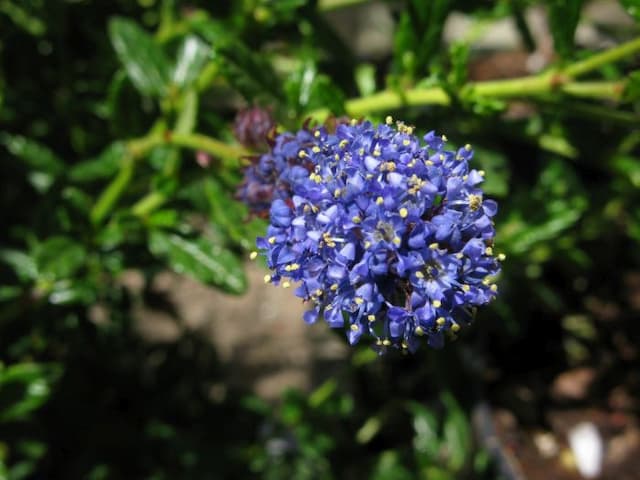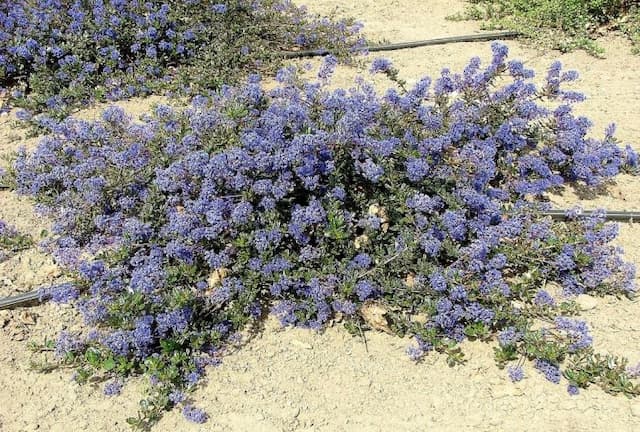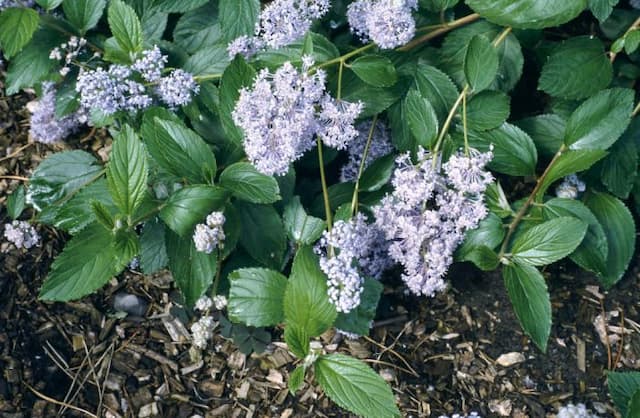California lilac Ceanothus 'Dark Star'

ABOUT
Ceanothus 'Dark Star', commonly known as California lilac, is a visually striking plant. It boasts dense, glossy evergreen foliage that creates a lush background for its standout feature, the deep blue to purple flower clusters. These vibrant blossoms appear in profusion in late spring to early summer, attracting bees, butterflies, and birds with their vivid coloration and sweet fragrance. California lilac's leaves are small and oval to narrowly oblong, with a leathery texture and a dark green hue that complements the dramatic flowers. The overall appearance of 'Dark Star' exudes a wild but refined beauty, often making it a favorite in gardens for its showy display and the contrast it offers against lighter foliaged plants.
About this plant
 Names
NamesFamily
Rhamnaceae
Synonyms
California Wild Lilac, California Mountain Lilac, Wild Lilac
Common names
Ceanothus 'Dark Star'.
 Toxicity
ToxicityTo humans
The California lilac, specifically the variety 'Dark Star', is not known to be toxic to humans. There are no well-documented symptoms of poisoning, as it is generally considered non-toxic. Therefore, ingesting parts of the 'Dark Star' California lilac does not typically result in adverse consequences for humans.
To pets
The 'Dark Star' California lilac is not known to be toxic to pets, including dogs and cats. It is generally considered non-toxic, and there are no reported symptoms of poisoning from ingestion. As a result, ingesting this plant should not cause harmful effects in pets. However, it is always important to monitor pets for any unusual reactions if they consume any plant material.
 Characteristics
CharacteristicsLife cycle
Perennials
Foliage type
Evergreen
Color of leaves
Green
Flower color
Blue
Height
6-8 feet (1.8-2.4 meters)
Spread
6-8 feet (1.8-2.4 meters)
Plant type
Shrub
Hardiness zones
7
Native area
California
Benefits
 General Benefits
General Benefits- Attracts Pollinators: Ceanothus 'Dark Star' provides abundant nectar and pollen that attract beneficial insects such as bees and butterflies.
- Drought Tolerant: Once established, this California Lilac is very drought-resistant, requiring minimal watering and suiting water-wise gardens.
- Low Maintenance: It typically requires little care beyond occasional pruning to maintain a desired shape and size.
- Fast Growth: This shrub grows relatively quickly, providing a faster fill-in for garden spaces and landscapes.
- Evergreen Foliage: The California Lilac retains its leaves all year, providing constant greenery and structure in the garden.
- Showy Blossoms: It produces vibrant blue flowers in spring or early summer, adding a splash of color to the landscape.
- Erosion Control: The deep root systems of Ceanothus 'Dark Star' help stabilize slopes and banks, reducing soil erosion.
- Wildlife Habitat: It offers shelter and nesting sites for birds and other native wildlife.
- Native Planting: Being a native plant, it supports local ecosystems and fits well into native planting schemes and xeriscaping.
- Aesthetic Appeal: Its rich dark blue flowers and dark green foliage make it an attractive addition to any garden design.
 Medical Properties
Medical PropertiesThis plant is not used for medical purposes.
 Air-purifying Qualities
Air-purifying QualitiesThis plant is not specifically known for air purifying qualities.
 Other Uses
Other Uses- California Lilac can be utilized to stabilize slopes and banks as its root system helps to prevent erosion by holding the soil firmly in place.
- This plant is suitable for creating low-maintenance hedge borders due to its dense growth habit, offering privacy and reducing noise pollution.
- Often used in xeriscaping, it requires minimal watering after establishment, making it part of water conservation efforts in gardens and landscapes.
- Dried California Lilac flowers can be used in potpourri making for their color and subtle fragrance, adding a natural element to home decor.
- California Lilac can serve as a habitat for beneficial insects like bees and butterflies, enhancing biodiversity and pollination in gardens.
- It can be trained to grow on a trellis or fence, providing a beautiful living screen with its ornate blooms.
- When planted in coastal areas, it can act as a windbreak, protecting other delicate plants from the harsh saline winds.
- The branches can be used in floral arrangements as a filler, adding volume and texture due to their lush foliage and striking blue flowers.
- California Lilac can be a valuable food source for wildlife, offering nectar and habitat for various species of birds.
- The shrub's adaptability allows it to be used in restoration projects to bring back native flora in areas disturbed by construction or environmental damage.
Interesting Facts
 Feng Shui
Feng ShuiThe plant California Lilac is not used in Feng Shui practice.
 Zodiac Sign Compitability
Zodiac Sign CompitabilityThe California Lilac is not used in astrology practice.
 Plant Symbolism
Plant Symbolism- Resistance: Ceanothus, commonly known as California lilac, is known for its resilience and ability to thrive in dry, challenging conditions, symbolizing tenacity and the ability to overcome adversity.
- Hope: The bright blue flowers of the California lilac are often associated with a sense of hope and optimism, especially as they bloom profusely in the spring after winter.
- Renewal: With its vibrant springtime blossoms, California lilac can represent new beginnings and the refreshing nature of renewal.
- Patriotism: The 'Dark Star' variety, with its deep blue hue, might evoke a sense of patriotism, reminiscent of the blue found in the American flag, especially since the plant is native to North America.
- Fragility: Despite its hardiness, the delicate flowers of the California lilac can also symbolize the fragility of life and the importance of cherishing each moment.
 Water
WaterCalifornia Lilac, or Ceanothus 'Dark Star', should be watered deeply but infrequently, allowing soil to dry out between waterings. During the growing season, water approximately once every 7 to 10 days, using roughly 1 to 2 gallons per plant, depending on the size and the weather conditions. Young plants will require more frequent watering to establish their roots, potentially every 5 to 7 days. Once established, reduce watering frequency to every 2 to 3 weeks, tapering off in cooler months. Always check the top few inches of soil for dryness before watering to avoid overwatering.
 Light
LightCalifornia Lilac thrives in full sun conditions where it can receive at least 6 to 8 hours of direct sunlight daily. The ideal spot for the plant would be in an area with unobstructed exposure to sunlight to ensure vigorous growth and abundant flowering. Avoid planting it in heavily shaded areas, as this can lead to poor blooming and a leggy growth habit.
 Temperature
TemperatureCalifornia Lilac does well in a range of temperature conditions but prefers a cooler coastal climate to hot inland areas. It can generally tolerate temperatures as low as 10 degrees Fahrenheit but is happier at temperatures between 35 and 85 degrees Fahrenheit. Extreme heat above 95 degrees Fahrenheit can be detrimental unless the plant receives adequate moisture.
 Pruning
PruningPrune California Lilac to maintain shape and encourage bushier growth, typically immediately after flowering in late spring or early summer. Pruning too late in the season can remove the next year's flower buds. Shape as necessary, removing dead or crossed branches, but avoid heavy pruning, as this can reduce flowering and potentially harm the plant.
 Cleaning
CleaningAs needed
 Soil
SoilCalifornia Lilac thrives in well-draining soils with a pH range of 5.5 to 7.5. A mixture of loam, sand, and organic compost is ideal, ensuring good drainage while retaining sufficient moisture without becoming waterlogged.
 Repotting
RepottingCalifornia Lilac, or Ceanothus 'Dark Star', is typically not repotted often as it is a woody shrub; repotting is only necessary if grown in a container and it becomes root-bound, which is generally every 2-3 years.
 Humidity & Misting
Humidity & MistingCalifornia Lilac prefers moderate humidity levels; however, it is quite adaptable and can tolerate the dry air conditions typical of most home environments without special humidity adjustments.
 Suitable locations
Suitable locationsIndoor
Ensure bright light, infrequent watering, and good airflow for California Lilac.
Outdoor
Plant in full sun, well-drained soil, water sparingly, and protect from harsh winds.
Hardiness zone
7-10 USDA
 Life cycle
Life cycleCeanothus 'Dark Star', also known as California lilac, begins its life cycle when seeds germinate, typically in the spring following scarification by wildfire or other disturbances. Seedlings establish themselves with a deep taproot, and then enter a rapid vegetative growth stage, developing woody stems and dark green leaves. Within a few years, the plant reaches maturity and begins its reproductive phase, producing clusters of deep blue or purple flowers in the spring, attracting pollinators such as bees and butterflies. After pollination, it produces fruits in the form of small, hard capsules that eventually dry and release seeds. The California lilac can live for approximately 10 to 25 years, and throughout its life, it may experience cycles of dormancy and resurgence, particularly in response to environmental factors like drought. Upon reaching the end of its lifespan, the plant will die back, at which point it may release a final burst of seeds that continue its legacy.
 Propogation
PropogationPropogation time
Spring to Early Summer
Ceanothus 'Dark Star', commonly known as California Lilac, is best propagated by semi-hardwood cuttings. This method usually takes place in late summer. To propagate by this method, a gardener would take a cutting of new growth that has begun to mature and harden slightly. The cutting should be about 4 to 6 inches (10 to 15 centimeters) long and include a few leaf nodes. The lower leaves are often removed, and the cut end may be dipped in rooting hormone to encourage root development before the cutting is placed in a well-draining soil mixture. The cutting needs to maintain high humidity and consistent moisture without being waterlogged, and it should be kept in indirect light until roots have established, after which it can be gradually acclimatized to more direct light and eventually planted out.









